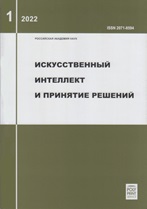|
|
Artificial Intelligence and Decision Making, 2018, Issue 1, Pages 76–84
(Mi iipr199)
|
 |
|
 |
This article is cited in 4 scientific papers (total in 4 papers)
Data analysis
Using shuffled frog-leaping algorithm for feature selection and fuzzy classifier design
I. A. Hodashinsky, M. B. Bardamova, V. S. Kovalev
Tomsk State University of Control Systems and Radioelectronics
Abstract:
This article, a new approach to designing fuzzy-rule-based classifier is considered. The fuzzy classifier construction includes the following stages:feature selection, generation of the classifier structure, optimization of the classifier parameters, and choice of the optimal classifier. At the first stage, according to the principle of "wrappers", binary shuffled frog-leaping algorithm are formed groups of relevant features on the classifiable data set. Since the randomness present in metaheuristics is capable of leading to the selection of various relevant features, several groups of features are formed. At the second stage, on each selected feature group, the structure of the fuzzy classifier is generated on the basis of the extrema of the observation table. The generated structures have the minimum possible number of rules, which is limited by the number of existing classes in the classified data set. The rules bases constructed in this way are simple for understanding and subsequent interpretation of the result obtained. The next step is to optimize the parameters of each classifier using a continuous shuffled frog-leaping algorithm. On a set of constructed classifiers, the optimal classifier is selected with respect to the accuracy and the number of features used, using the statistical Akaike informational criterion. The effectiveness of the proposed approach is tested on 15 KEEL data sets. The results obtained are statistically compared with the results of similar algorithms. The new approach to designing fuzzy classifiers proposed in the article allows to reduce the number of rules and attributes, thereby increasing the interpretability of classification results.
Keywords:
fuzzy classifier, parameters optimization, features selection, shuffled frog-leaping algorithm.
Citation:
I. A. Hodashinsky, M. B. Bardamova, V. S. Kovalev, “Using shuffled frog-leaping algorithm for feature selection and fuzzy classifier design”, Artificial Intelligence and Decision Making, 2018, no. 1, 76–84; Scientific and Technical Information Processing, 46:6 (2019), 381–387
Linking options:
https://www.mathnet.ru/eng/iipr199 https://www.mathnet.ru/eng/iipr/y2018/i1/p76
|

| Statistics & downloads: |
| Abstract page: | 17 | | Full-text PDF : | 4 | | References: | 1 |
|




 Contact us:
Contact us: Terms of Use
Terms of Use
 Registration to the website
Registration to the website Logotypes
Logotypes








 Citation in format
Citation in format 
